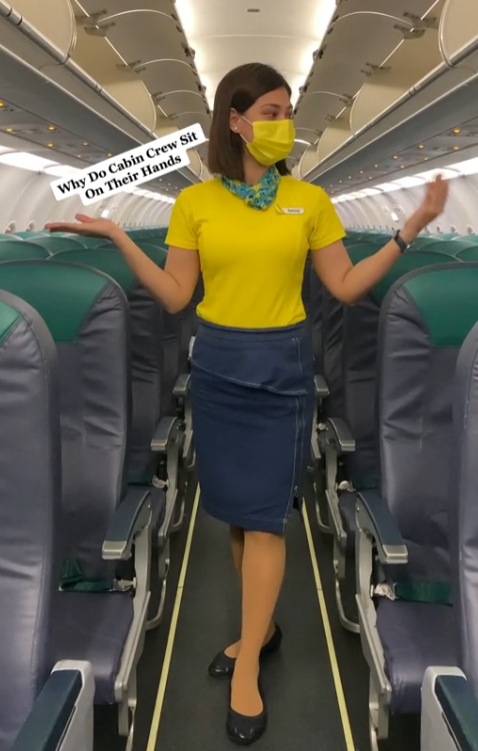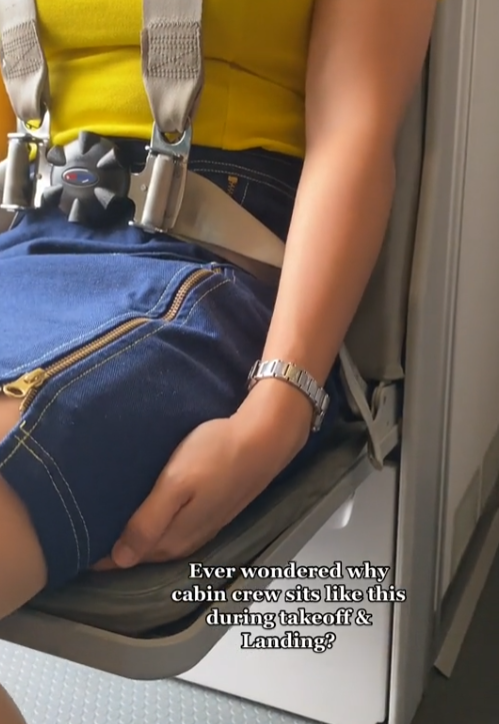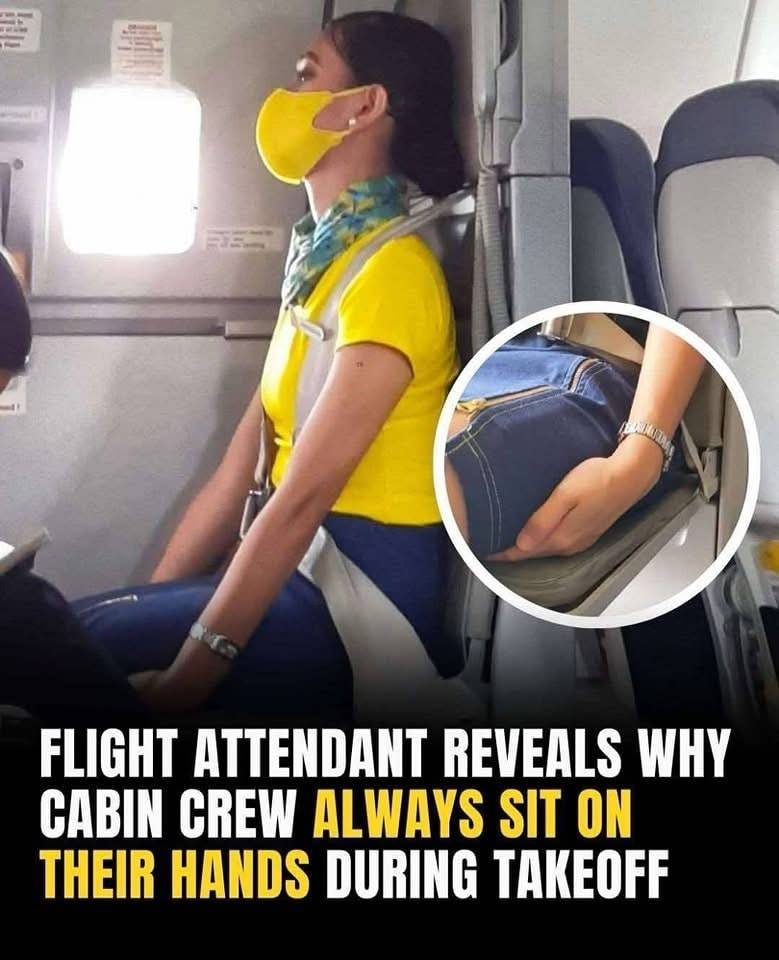In air travel, flight attendants perform a dual and essential role. They are highly visible service providers, serving drinks and making passengers comfortable, but their primary, non-negotiable function is as skilled safety professionals tasked with maintaining the security and welfare of all individuals on the aircraft. Among the various precise procedures they follow, one practice frequently raises questions and curiosity among observant passengers: the specific bracing position the cabin crew assumes during the critical phases of takeoff and landing. This posture, often misinterpreted as a casual seating choice, is a mandatory, vital safety technique.
I. Understanding the Bracing Position Through the Eyes of Cabin Crew

When passengers see flight attendants strapping into their jump seats and placing their hands under their thighs during landings and takeoffs, it often raises questions about the purpose of this seemingly odd position. However, professionals like Cebu Pacific flight attendant Henny Lim, using platforms like TikTok to educate the public, clarify that there’s a deliberate, specific, and scientifically backed reason behind this posture.
The Deliberate Steps of the Bracing Position
Lim explains that the bracing position consists of several deliberate, specific steps, each designed to maximize stability and control over the body during an unexpected event:
- Secure Fastening: The initial step is securely fastening the seatbelt, ensuring it is low and tight across the hips.
- Upright Posture: The attendant must be sitting upright in the jump seat, with their back firmly against the seatback, maintaining a rigid spine.
- Hands Positioned: The key, often-observed element is placing hands on the thighs with thumbs tucked in, followed by keeping the arms relaxed but controlled. Tucking the thumbs inward prevents them from being injured or broken by impact forces or flailing, which could compromise the attendant’s ability to operate emergency doors or assist passengers immediately after an impact.
- Feet Position: Both feet must be placed flat on the floor, slightly behind the knees, providing a stable foundation and preparing the legs to absorb upward or forward force.
- Head Position: The head is often held firmly against the headrest, or angled down toward the knees (depending on the direction of potential impact and seat orientation), again reducing whiplash and secondary impact.
II. The Science Behind the Bracing Position: Limiting Movement and Impact

The complex, precise nature of the bracing position is entirely rooted in physics and injury prevention. The main purpose is to limit body movement in the event of an emergency, thereby significantly lowering the chances of injury upon high G-force impact.
Flailing Reduction and Impact Mitigation
- Limiting Flailing: Regulatory bodies such as the Federal Aviation Administration (FAA) emphasize the critical significance of the bracing position. In an FAA memo, it is clearly stated that the position serves two key functions: limiting flailing and reducing secondary impact. Flailing—the uncontrolled, violent movement of limbs during a crash—can result in severe secondary injuries (broken wrists, arms, or fingers) as limbs strike internal cabin components or the attendant’s own body. Tucking the hands and maintaining firm posture reduces this risk, ensuring the attendant remains functionally intact.
- Reducing Secondary Impact: Secondary impact refers to the body hitting objects after the initial force of the crash. Assuming the bracing position helps to position the body—especially the head and spine—against the surface it is most likely to hit during impact. For instance, positioning the head correctly minimizes the intensity of secondary impact injuries, such as striking the dashboard of the jump seat or the partition wall. By maintaining a firm, structured posture and staying securely seated, flight attendants are better equipped to endure the physical forces of a crash landing with minimal personal harm.
Safety Standards According to Regulators
The FAA and other international regulators mandate specific jump seat and bracing protocols not just for cabin crew, but also for specific passenger seating (the “brace for impact” position is well-known). The consistency of the crew’s position ensures they are protected so they can transition immediately into their post-crash duties. A physically injured crew member cannot perform the life-saving tasks of opening doors or organizing evacuation.
III. The Psychological Preparation: The “Silent Review”

Simultaneously with adopting the physical position, flight attendants engage in a crucial mental preparation process known as the “silent review” or “30-second review.” This mental exercise transforms the routine from a purely physical act into a cognitive rehearsal of emergency procedures.
Rehearsing the Emergency
While sitting securely in their jump seats, flight attendants carry out what Lim refers to as a “silent review,” mentally running through the emergency procedures specific to their current seating position on that particular aircraft.
- Door Operation and Equipment Location: This includes vividly recalling how to operate their assigned emergency exit or door (which requires specific, often complex steps that vary by aircraft model), rehearsing the location and operation of emergency equipment nearby (fire extinguisher, oxygen bottles, first aid kits), and scanning for external visual cues (e.g., checking for fire outside the door).
- Safety Commands: They also rehearse the safety commands they must shout to passengers immediately after a crash, ensuring the tone and volume are correct and the sequence is memorized (e.g., “HEADS DOWN! STAY DOWN! RELEASE SEATBELTS! COME THIS WAY!”).
- Scanning for High-Risk Passengers: Additionally, they scan the cabin area assigned to them, noting the location of high-risk passengers (unaccompanied minors, elderly, passengers with disabilities) and potential obstacles (oversized carry-on bags), anticipating where immediate assistance will be needed.
This intense mental rehearsal, completed in seconds, ensures that if a critical event occurs, the flight attendant’s response is instinctive, immediate, and correct, eliminating precious seconds of hesitation that could cost lives during a rapid evacuation.
IV. Crew Members Share Their Views on Safety and Professionalism
Henny Lim’s explanation of the bracing position reflects a growing, positive trend of flight attendants using social media platforms such as TikTok and Instagram to demystify safety procedures and share their personal experiences, enhancing transparency and trust.
Safety Education and Transparency
- Informing the Passenger: By sharing the “why” behind procedures like the silent review and the bracing position, flight attendants are transforming seemingly arbitrary rules into understandable safety requirements. This approach helps passengers become more informed and develop a deeper appreciation for the commitment of those responsible for their safety during air travel.
- Professionalism: Flight attendants like Lim, Destanie, and Esther Sturrus use their platforms to offer honest reflections on both the challenges and rewards of their career. While some tales entertain viewers (like Destanie sharing stories about the outrageous behavior some passengers use to try to secure seat upgrades), they consistently emphasize the need to follow safety rules and respect the professionalism of the cabin crew.
Navigating the Demands of the Profession
The commitment to passenger safety remains strong, despite the intense difficulties inherent in the job. Flight attendants recognize the tough aspects of their career, including:
- Handling Demanding Passengers: Dealing with customer service issues while maintaining safety standards.
- Working Under Pressure: Functioning calmly and effectively in emergency situations.
- Unpredictable Schedules: Managing long hours, jet lag, and constantly changing work environments.
The bracing position is far more than just a routine—it’s a vital safety practice designed to reduce the risk of injury in emergencies, ensuring the cabin crew can execute their primary role as first responders.


